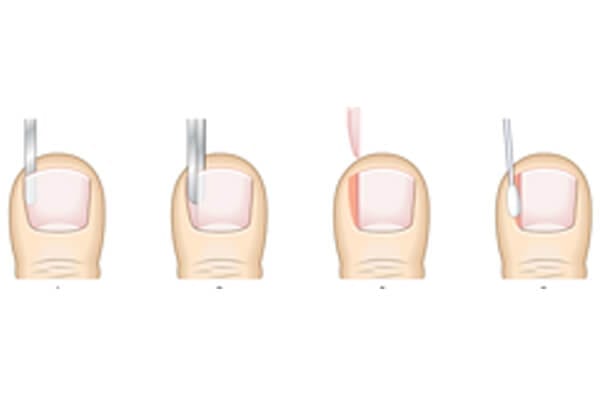What is an ingrown toenail?
Many people may have heard of how painful an ingrown toenail can be.
An ingrown toenail clinically also referred to as onychocryptosis occurs when the nail grows into the nail edge causing pain and sometimes an infection.It commonly occurs when there has been a change to the shape of the nail causing it to penetrate into the skin rather than sitting on top, commonly seen on the big toe either on one side or both sides of the nail. As a result, pressure builds up on the skin causing pain, swelling, bleeding and in some occasions an infection.
What causes an ingrown toenail?
There are many reasons why it can occur some of which are listed below:
- Trauma/ injury to the toe/s
- Tight-fitting footwear (narrow shoes)
- Improper nail cutting
- Oedema (swelling of the feet)
- Lack of maintenance of regular foot hygiene
- Infection of the nail or nail bed
How is an ingrown toenail treated?
There are a number of treatment options available for ingrown toenails:
First line treatment can begin adopted at home:
- Gently lifting the nail and ensure the nail is cut straight, do not cut down the edges as this may lead to further ingrown complications.
- Soak your toe/ foot in a warm salt water bath. The ratio of half a bucket of warm water to 3 tablespoons of salt for 3-5min, which help reduce, cleanse out any debris or infection which may be leading to the pressure. This can also help soften the nail.
- Dressing the nail with betadine and bandage to protect the area and reduce the risk of infection.
- Wearing comfortable shoes and socks, ensuring you are providing sufficient space for your toes in your shoes.
- We recommend not to wear closed shoes to limit the pain until the issue is fixed
Podiatric treatment for In-Grown Toenails
Relatively speaking an Ingrown toenail can be fixed quickly and easily in our clinic depending on the extent of the problem. The podiatrist may be able to remove a small wedge of the nail to improve the problem. The nail will need to be filed to ensure no further ingrown toenails occur. Antibiotics may be needed from your doctor if an infection is present.
Surgical treatment for Ingrown Toenails
Usually, surgical intervention is required if the patient has ongoing or recurring issues with ingrown toenails or if the nail is heavily infected and conservative treatment has not been adequate enough to resolve the issue.
The surgical procedure involves a small resection of the nail under local anaesthetic. Then the area is cauterized with Phenol to prevent the nail from growing back. Following the procedure, adequate amounts of dressings are applied and will be reviewed by the podiatrist to ensure the area is being healed properly. The toe usually heals within a couple of weeks. Read more on our Surgical Services page.
How to Prevent Ingrown Toenails?
Prevention is always key. Key steps to preventing an ingrown toenail is to ensure:
- Proper foot hygiene is maintained
- Ensuring the nails are being cut straight
- Wearing adequate footwear appropriate for your activity
Conclusion
An ingrown toenail can be painful but with simple preventive measures, it can be avoided. However, in situations where it causes pain, inflammation or bleeding, conservative and surgical treatment options are available.


